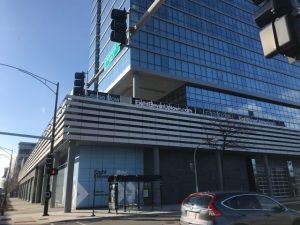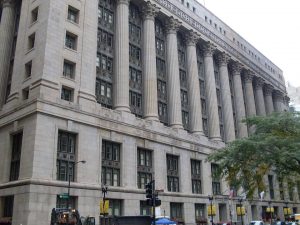By Jeanette Almada of LISC Chicago’s New Communities Program

Two new affordable apartment buildings are benefiting Pilsen residents in two ways: they’re providing residents with high-quality, low-cost housing, and they’re occupying vacant industrial sites that had become neighborhood eyesores.
The recently completed 45-unit Casa Morelos Apartments – one of the two resident buildings – sits on previously vacant land at 2015 S. Morgan St. that, in addition to contributing nothing in the way of taxes or services, had become a source of blight.
“It had been vacant for years before we bought it, and people began to just dump all kinds of junk there,” said Guacolda Reyes, director of community development at NCP lead agency The Resurrection Project, the non-profit developer that built the apartment building.
In April 2006, TRP purchased the plot of a little more than two acres from Alivio Medical Center, which operates a clinic at 21st and Morgan streets, within blighted industrial land that dots several blocks around the medical center and Casa Morelos.
“All of this vacant land was gray and dusty, under-used, under-everything,” said Teresa Fraga, a medical center board member. The center, a key NCP partner agency, sold TRP’s development site for a less-than-market-rate price, Fraga said.
The seven-story Casa Morelos, completed earlier this summer, has begun leasing its one- to three-bedroom apartments, with 552 square feet to 1,116 square feet of space. The apartments will be fully occupied by fall, Reyes said.
Under terms of the developer’s agreement with Illinois Housing Development Authority, which provided the project’s low-income-housing tax credits, most of the apartments will command affordable rents that begin at $530. Four of the apartments will be leased at market-rates from $800 to $1,050, Reyes said, and another four apartments will be leased to Section 8 voucher tenants.
A second, 73-unit building
On that same two-acre site, and directly south of the new apartment building, at 2021 S. Morgan St., TRP this spring started construction of the 73-unit Casa Maravilla.

That $20 million, five-story building, designed by Weese Langley Weese, will be completed by spring 2010, said Reyes. While senior buildings constructed throughout the city in recent years have tended to consist of fairly small, studio-sized apartments, Casa Maravilla will include 13 two-bedroom units.
“We want to accommodate our Latino housing needs and lifestyles,” Reyes said. “These apartments are big enough so that seniors who want to share their apartment with a sister, a brother or a friend can do so.”
In addition to the two-bedroom units, Casa Maravilla will have a mix of studio and one-bedroom apartments. All will range from 700 to 1,100 square feet of space. Built under Chicago Green Homes program guidelines, the senior building will have several green elements, including a green roof and permeable pavement.
Income-based rents for tenants who are at least 55 years old and who earn 60 percent down to 30 percent of the Chicago area median income, will range from $350 to $550 for studios; $600 to $800 for one-bedroom apartments; and $750 to $900 for two-bedroom units.
Casa Maravilla has received up to $4 million in HOME loan funds from the City of Chicago. A combination of $800,000 in city low income housing tax credits and $883,342 in Illinois Housing Development Authority low income housing tax credits will generate an estimated $13.2 million in equity for the project, according to officials from the city’s Community Development Department.
National Equity Fund Inc. is tax credit syndicator for the project, which also received $108,400 in investment donated tax credits.
The senior building’s location next door to Alivio Medical Center is a big plus, said Reyes. A Chicago Department of Senior Services satellite center will operate from the ground floor. Other amenities will include a large ground floor community space and a fitness center.
Finding appropriate new use for unused industrial lots – a rare opportunity to modernize segments of the long established Pilsen neighborhood where vast land tracts are rarely available for larger developments – has brought several factions of the Pilsen neighborhood together.
TRP, long involved in building affordable housing and providing social services, now works with block clubs and community groups such as Fraga’s Pilsen Neighbors Community Council. All of those factions came together through NCP about three years ago, said Fraga, and the community’s resulting quality-of-life plan articulates several goals for the neighborhood, including how to re-use those former industrial properties.
El Paseo on the way
Not the least of those plans is the eventual conversion of the unused rail tracks along Sangamon Street, between Cermak Road and 16th Street, into the north/south landscaped pedestrian corridor to be called El Paseo. Since rail cars years ago stopped serving industrial users in the area, the land around them has been threatened with blight.

El Paseo is modeled after the Mexican paseos found in so many Mexican villages – town squares where residents come to meet. TRP, Pilsen Neighbors and community leaders are now working with city officials to gain control of the rail company-owned tracks, said a spokesman from Alderman Daniel Solis’ 25th ward office.
The city, which is negotiating a use agreement with the rail track owner, already owns land to the east and west of the tracks which is slated for use as part of the El Paseo corridor, Fraga said. Once completed, Alivio and TRP expect to share management of the paseo. In roughly five years Fraga hopes El Paseo will attract all the social factions that are today’s Pilsen.
“Historically we have had differences,” she said. “The art district on Halsted Street differed with the families who live in West Pilsen. But we are changing that and, when the Paseo is there, we will all gather as one neighborhood and all those differences won’t matter.”

![Reblog this post [with Zemanta]](http://img.zemanta.com/reblog_e.png?x-id=e19a7e2c-ab6f-4b64-8397-59a843b4a4d5)










Be First to Comment